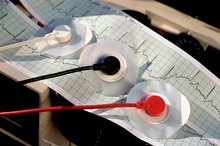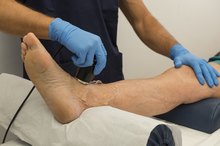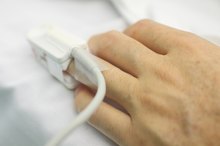Contraindications for Electrostimulation
Electrostimulation therapy, or electrotherapy, is a modality commonly used by physical therapists which involves sending an electrical current through electrodes placed on the skin. According to "Clinical Electrotherapy" by Roger Nelson and Dean Currier, electrostimulation can help in the treatment of pain, inflammation, wound healing, joint dysfunction, re-education of muscles and impairments in circulation. Though electrostimulation is safe to treat many conditions, contraindications do exist.
Carotid Sinus
Electrostimulation therapy should not be applied over the carotid sinuses on the lateral part of the neck. According to assistant professor Dr. James Fletcher of the University of Central Arkansas, such use might cause a sudden increase in blood pressure or a drop in heart rate.
Cancer
Contraindications for a TENS Machine
Learn More
Electrostimulation should not be used over tumors or cancerous tissue, as the current produced may promote the spread of cancer cells to other parts of the body.
Broken Skin
Unless being used specifically for wound care, electrical stimulation should not be used over irritated or broken skin, since this can be uncomfortable for the patient.
Disoriented Patients
Contraindications for Ultrasound Therapy
Learn More
According to Fletcher, electrotherapy should not be attempted with patients who are either disoriented or too young to give coherent feedback regarding the intensity of stimulation. Electrostimulation is only for patients who can express discomfort reliably and verbally.
Metal
Treatment with electrostimulation should be avoided near metal or over areas of the body with metal staples, implants or pins. The use of topical solutions containing metal ions should also be avoided under electrodes. Metal is an excellent conductor of electricity, explains Fletcher, and stimulation over those areas could lead to injury or pain.
Heart
Electrode placement is contraindicated peripheral to the heart, since the signals might interfere with the heart's electrical signals. Electrotherapy should also be avoided in patients with pacemakers and defibrillators, suggests Fletcher. Electrodes should not be placed in the thoracic area in patients with known heart disease.
Pregnancy
Wild Iris Medical Education, Inc, a provider of continuing education courses for health care professionals, explains that electrical stimulation should not be used on patients in their first trimester of pregnancy. Fetuses are more susceptible to birth defects and abnormalities in these early weeks.
Laryngeal Musculature
The laryngeal musculature over the throat should be avoided with electrotherapy, explains Wild Iris Medical Education. The fear is that the electrical current could cause the muscles to spasm, which can lead to difficulty breathing.
Related Articles
References
- Wild Iris Medical Education, Inc: Electrical Stimulation Therapy
- "Clinical Electrotherapy," by Roger M. Nelson and Dean P. Currier, 1999









